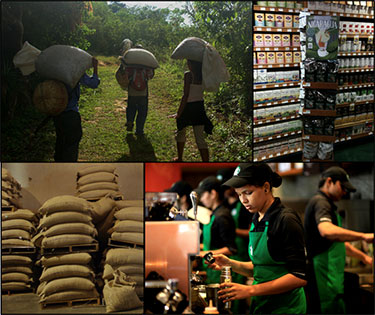5.4 The Global Agriculture System: Feeding Everyone
Despite agriculture’s tremendous productivity, food shortages, malnutrition, and famines are common around the world. How can this be? Many people assume that the world’s agricultural systems are not capable of producing enough food for everyone, but this is incorrect. Evidence from agricultural research demonstrates that there is enough worldwide agricultural capacity to feed everyone on the planet.[1] The problem is that this capacity is unevenly distributed and the power is the hands of a few global powers, i.e. the wealthiest nations, the United States being among them. Some countries produce much more food than they need, and others much less. In addition, distribution systems are inefficient and much food is lost to waste or spoilage. It is also true that in an agricultural economy food costs money, and worldwide many people who are starving or undernourished lack food because they cannot pay for it, not because food itself is unavailable.
Let’s return for a moment to the concept of meals and where our food actually comes from. Walking down the aisles of our local grocery store, we are surrounded by products that come from far away: apples from Chile, coffee from Guatemala, beans from India. This is evidence that our economy is organized around what anthropologists refer to as a world system, a complex web through which goods circulate around the globe. In the world system, complex chains of distribution separate the producers of goods from the consumers. Agricultural products travel long distances from their points of origin to reach consumers in the grocery store, passing through many hands along the way. The series of steps a food like apples or coffee takes from the field to the store is known as a commodity chain.

The commodity chain for agricultural products begins in the farms where plant and animal foods are produced. Farmers generally do not sell their produce directly to consumers, but instead sell to large food processors that refine the food into a more usable form. Coffee beans, for instance, must be roasted before they can be sold. Following processing, food moves to wholesalers who will package it for sale to retail establishments like grocery stores. As foods move through the commodity chain, they become more valuable. Coffee beans harvested fresh from the field are worth $1.40 per pound to the farmer, but sell for $10–$20 at Starbucks.[2]
The fact that food is more valuable at the end of the commodity chain than at the beginning has several consequences for human communities. The most obvious of these is the reality that farming is not a particularly lucrative occupation, particularly for small-scale farmers in developing countries. Though their labor makes profit for others, these farmers see the lowest financial returns. Another effect of global commodity chains is that food moves very far from its point of origin. For wealthy people, this means having access to a variety of foods in the grocery store, including things like strawberries or mangos in the middle of winter, but in order to serve markets in wealthy countries, food is diverted away from the locales where it is grown. When quinoa, a high-protein grain grown in Bolivia, became popular with health enthusiasts in wealthy countries, the price of this food more than tripled. Local populations began to export their quinoa crop rather than eating it, replacing this nutritious traditional food with white bread and Coca-Cola, which were much cheaper, but contributed to increased rates of obesity and diabetes.[3] The global travels of the food supply have also affected social relations that were once strengthened by participation in food growing and sharing. Distance and competition have replaced these communal experiences. Many people yearn for more connection with their food, a sentiment that fuels things like “foodie culture,” farm-to-table restaurants, and farmer’s markets.
Reflection: What are some of the causes for inequities in the availability of food?
Media Attributions
- Coffee commodity chain © Isaac Shearn is licensed under a CC BY-NC (Attribution NonCommercial) license
- Food and Agriculture Organization of the United Nations, The State of Food Insecurity in the World (Rome: FAO, 2015) ↵
- Information about the current prices paid to coffee farmers is available from the International Coffee Organization: http://www.ico.org/coffee_prices.asp ↵
- This phenomenon has been observed in many countries. For an ethnographic analysis of the health effects of the decline of traditional foods in Guatemala, see Emily Yates-Doerr, The Weight of Obesity: Hunger and Global Health in Postwar Guatemala (Berkeley: University of California Press, 2015). ↵
a complex economic system through which goods circulate around the globe. The world system for food is characterized by a separation of the producers of goods from the consumers.
the series of steps a food takes from location where it is produced to the store where it is sold to consumers.

